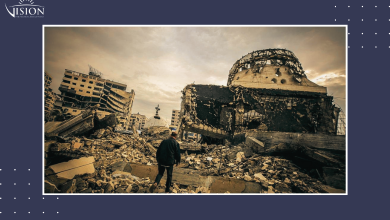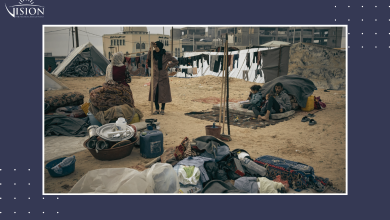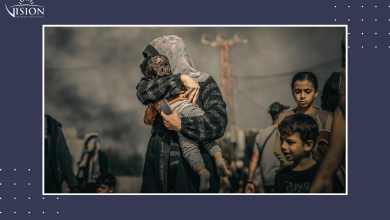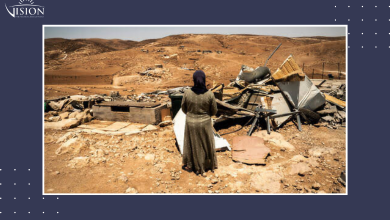Occupation’s Stranglehold in the West Bank: What is the Palestinian Authority Counting On?
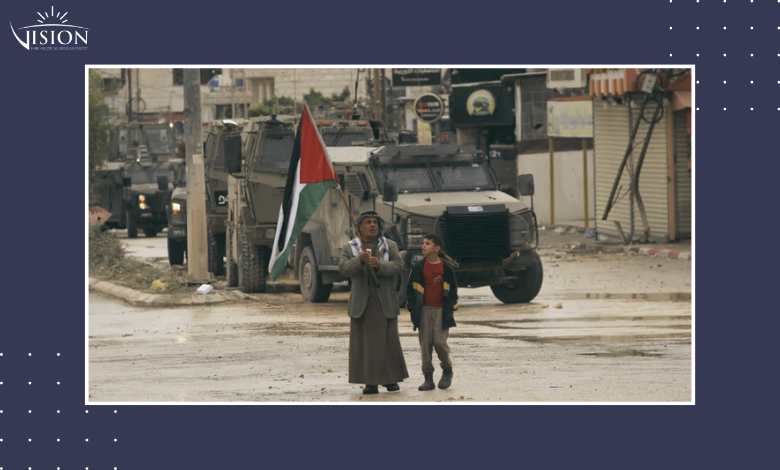
Occupation’s Stranglehold in the West Bank
The Israeli occupation is accelerating the pace of its policies in the West Bank through a complex and multi-layered strategy. Most notably, it has continued its military operations in the Jenin and Tulkarm refugee camps for the third consecutive month, installed more than a thousand gates and checkpoints at the entrances of Palestinian villages and cities, and officially adopted the use of the term “Judea and Samaria” to refer to the West Bank.
And it doesn’t stop there. As Israel continues to withhold clearance revenues, further crippling the Palestinian Authority’s economic and financial stability, it relentlessly pushes forward with its settlement expansion. Thousands of new housing units are being built, unauthorized outposts are being legalized, and strategic infrastructure projects are rolled out across the West Bank—each move carefully designed to advance the Israeli settlement agenda at the expense of Palestinian land and sovereignty.
Al Jazeera Net and the Vision Center for Political Development surveyed the opinions of a group of experts, academics, and politicians in an effort to understand what the future holds for the West Bank and the range of options available to the Palestinian Authority.
These views were presented through the following themes and questions:
- What objectives does the Israeli occupation seek to achieve in the West Bank?
- Does the occupation, through its continued presence in the Jenin and Tulkarm camps, aim to reimpose military rule over the West Bank?
- Is the Israeli occupation interested in dismantling the Palestinian Authority?
- What options does the Palestinian Authority have to confront Israel’s plans?
The experts’ opinions are summarised as follows:
- Israel uses the pretext of security to pursue strategic goals aimed at altering the geographical and demographic composition of the West Bank.
- Israel seeks to re-establish control and impose military rule over the West Bank by redividing it into zones and transforming it into a system of self-administered local governments.
- The acceleration of Israeli policies in the West Bank aims to prevent any future scope for any option that could provide a political umbrella or reference point for Palestinians.
- Netanyahu’s government is using settlers as a security arm to kill, destroy, and intimidate Palestinians with the goal of expelling them from the West Bank and tightening control over the area.
- The continued Israeli presence in the Jenin and Tulkarm refugee camps aligns with the occupation’s covert agenda—to change the legal status of these camps and integrate them into nearby Palestinian cities.
- We are witnessing a new, violent, terrorist model of governance practiced by the Israeli military establishment in coordination with settlers, aimed at triggering internal displacement and turning Palestinian cities into open-air prisons and concentration camps, controlled by Israel even without its direct presence in them.
- The dissolution of the Palestinian Authority in its current form is a political objective of the occupation.
- The Palestinian Authority has several options, depending on the extent of its willingness to act upon them—foremost among them being the activation of the resolutions emanating from the Palestinian National and Central Council in 2015, which includes the decision regarding the potential dissolution of the Authority itself.
- Betting on or waiting for change will yield no results. The real option is to sever all ties with Israel and face the consequences collectively, as the current reality is no longer physically or morally sustainable.
- The PA can strengthen the internal front by empowering the Palestinian masses to develop resistance mechanisms against Israeli plans on a large scale.
- The Authority must return to the Palestinian people by holding comprehensive presidential and legislative elections, to renew political legitimacy and rebuild trust between the public and the leadership.

Hassan Khreisheh
First Deputy Speaker of the Palestinian Legislative Council (PLC)
The declared Israeli objective is to combat the resistance in the West Bank refugee camps, starting with the Jenin camp due to its symbolic significance since the Second Intifada, during which the occupation failed to eliminate the idea of resistance. This same ‘rationale’ is presented to ‘justify’ the targeting of the Tulkarm camps by the occupation.
However, we need to analyse the Israeli mindset more deeply: the occupation is pursuing a strategic goal of eliminating the Palestinian refugee camp as a residential space. The camps symbolize the refugee issue and the right of return—both narratives that Israel aims to erase, especially after targeting UNRWA (the United Nations Relief and Works Agency).
The second objective in Israel’s strategic planning is to reinstate Israeli military rule over the West Bank by redividing it into separate zones. Through its attacks on the refugee camps, the occupation seeks to integrate these camps into the urban fabric as mere suburbs of nearby cities—an approach it aims to replicate across remaining areas.
This Israeli strategy relies heavily on using settlers as an extension of the occupation army, carrying out the regime’s brutal tasks—setting fires, killing, seizing land, uprooting trees, distributing eviction notices, setting up checkpoints, and legalizing outlawed settlement outposts. All of these actions are part of a calculated effort to impose full military control over the West Bank, with the ultimate goal of erasing Palestinian presence and history, as evidenced by the use of terms like “Judea and Samaria” to reframe the region as part of Israel’s expanding territory.
The American nexus is evident in the endorsement of these plans, which unfold against the backdrop of a swift and deliberate annexation campaign targeting “Area C”—the region designated under the Oslo Accords, constituting over 60% of the West Bank. This strategy is not just a political maneuver; it’s a calculated effort to solidify Israeli control and eliminate any prospects for a viable Palestinian state.
During the recent genocidal onslaught by the Israeli occupation, it became clear and undeniable that the target was not just the resistance or its fighters, but all Palestinians. For anyone who was counting on or waiting for any political solution from the United States or elsewhere, it has now been definitively proven that such hopes are in vain.
On the other hand, Israel no longer trusts the Palestinian Authority or regards it as relevant—evident in its reoccupation of refugee camps located in Area A, which are supposed to be under full Palestinian control and sovereignty. The PA is clearly being weakened but not completely dismantled, allowing it to continue serving a functional role dictated by the occupation.
While the PA has several options at its disposal, its willingness to act upon them remains in question. Unfortunately, since the ‘Toofan Al-Aqsa’ operation, the PA has distanced itself from this major event, declaring it is not part of the ongoing conflict, and framing it solely as a battle against the resistance.
If the Palestinian Authority truly wishes to activate its available options, it must first implement the decisions agreed upon by the Palestinian consensus, as issued by the Palestinian National and Central Councils since 2015, including the following:
- First: Revoking the Oslo Accords and rejecting all their outcomes, including security coordination with the occupation.
- Second: Boldly and explicitly demanding that Arab states halt their normalization agreements with Israel and end their silence in the face of ongoing massacres against Palestinians.
- Third: Reinvigorating Palestinian diplomacy to mobilize global public opinion against the occupation and to build pressure for an immediate end to the genocidal campaign. Simple existing models can be built upon—such as empowering Palestinian diaspora communities abroad. The example of Palestinians in Europe stands out, as they successfully mobilized millions of demonstrators in protests against the genocide in Gaza.
- Fourth: The Palestinian Authority must take the outcomes of previous national dialogues seriously, particularly the recent Beijing Dialogue, and implement its resolutions by forming a national coalition government to strengthen the resistance against the occupation.
- Fifth: The Palestinian Authority and all factions must confront the reality that this is an existential battle for the Palestinian people. In the face of Israel’s relentless aggression, unity is no longer a choice—it is an absolute necessity. The time to transcend the divisions and fragmentation that have plagued the Palestinian cause is now. They must stand united, as one force, if they are to resist and survive.
- Sixth: Voices that undermine the resistance or absolve the occupation must be confronted and silenced. At a time when the enemy’s agenda is clear—rooted in settler-colonial domination and the erasure of Palestinian identity—there can be no tolerance for narratives that weaken our struggle. The Palestinian people must unapologetically assert their own liberation project, one that directly challenges and dismantles the occupation’s colonial framework. This is not a moment for hesitation—it is a battle for existence.

Ahmad Rafiq Awad
President, Jerusalem Center for Strategic Studies, Al-Quds University
Israel’s objectives in the West Bank center on the partial or full annexation of Area C—and, when politically and militarily feasible, parts of Area A as well. This strategy also includes the systematic destruction, depopulation, and transformation of refugee camps’ geographic and demographic composition, serving as a prelude to erasing the refugee issue entirely—particularly following the sidelining of UNRWA.
It further aims to dismantle the two-state solution by dissolving, impoverishing, and weakening the Palestinian Authority to the point of collapse—stripping it of any political legitimacy or capacity to advocate for a Palestinian state. At the same time, Israel seeks to eliminate what it calls the “armed Palestinian phenomenon,” namely the resistance.
As for the other goals Israel promotes, they are merely political pretexts meant as a justification and cover for its actions. The prolonged presence of Israeli forces in the refugee camps aligns with the real objectives outlined earlier: first, to change the legal and territorial status of these camps by integrating them into the surrounding Palestinian urban areas; and second, to undermine the Oslo-era territorial designations of Areas A, B, and C.
Israel is moving aggressively to reshape its relationship with the Palestinians, and its continued presence in West Bank cities serves as a prelude to annexation. The occupation seeks first to delegitimize the Palestinian Authority (PA) in the eyes of the Palestinian people, and then to render it functionally obsolete through direct military control on the ground.
While the PA was established as part of an Arab and international consensus, Israel rejects this model, and instead pushes for alternative governance structures based on dependency—be it through municipalities, tribal leadership, or direct military rule—after binding all Palestinian needs and interests to its own “civil administration.”
Given this, it is time for the PA to seriously reconsider the nature and terms of its relationship with Israel. It cannot afford to wait for or rely on allies, as Israel has effectively undermined even the international system through its ability to exert influence and reshape the narrative globally.

Hasan Ayoub
Professor of Political Science, An-Najah National University
The current trajectory in the West Bank, shaped by ongoing Israeli practices, points toward a foreseeable future defined by fragmented ghettos—effectively separate prisons—isolated from one another by a sprawling network of military checkpoints and gates, particularly around settlement blocs and strategic junctions linking West Bank governorates.
This reality suggests that in the coming years, Palestinian movement and mobility will be severely restricted, increasingly dependent on permits issued by the Israeli occupation. Such a system draws clear parallels to the apartheid regime once imposed on Black South Africans, echoing the mechanisms of racial segregation and control.
Compounding this is the dangerous wave of internal displacement underway across the West Bank—perhaps the most alarming development—carried out through coordinated efforts between Israeli settlers and the military establishment.
We are witnessing a new, violent settler-colonial model: a systematic, terror-driven campaign targeting small Palestinian towns adjacent to settlements, as seen starkly in the Jordan Valley. These are not to be taken as isolated incidents—as they are part of a deliberate strategy of territorial conquest and depopulation.
Under this model, Palestinian cities are being transformed into open-air prisons, with Israeli forces maintaining a permanent presence—not through visible offices or administrative centers, but through unchecked military control. This marks a new phase in the occupation: one where domination is enforced without formal governance, cementing apartheid-like conditions under a militarized regime.
Therefore, the current Israeli military presence in refugee camps across the northern West Bank is not a temporary measure—it is the sustainable foundation of a long-term reality that Israel is actively shaping. This new status quo is not viewed by Israel as a problem, but rather as the defining feature of its future relationship with Palestinians, particularly in refugee camps and areas where resistance may exist; so that the Israeli military presence becomes a habitual part of the daily life of the Palestinians.
Crucially, this military entrenchment is not driven by security concerns, but by a broader geopolitical agenda aimed at fundamentally transforming the West Bank. Israel is constructing a new sociopolitical reality—one in which the permanent presence of its military forces becomes normalized in Palestinians’ daily lives, enforced with increasing brutality and impunity, echoing the devastation inflicted on Gaza.
The message is clear: Palestinians are expected to accept perpetual occupation, escalating violence, and the dismantling of their political and social spaces under the weight of militarized control.

Ayoub: Israel is creating a new reality in the West Bank, and Palestinians are expected to accept the Israeli military presence—one that is increasingly brutal and criminal (Associated Press).
This is precisely why Israel continues to signal that the genocidal model used to destroy Gaza could be replicated in the West Bank—a clear warning to the Palestinian Authority to either accept Israel’s new imposed reality or face total irrelevance.
In doing so, Israel is laying all the groundwork to make that threat a reality. Through its on-the-ground actions, it is bringing the situation to the brink of a calculated and deliberate collapse of the Palestinian Authority.
A deep power struggle is unfolding within Israel over the future of the West Bank and the Palestinian Authority. One camp—rooted in the security and military establishment and once backed by influential opposition factions like the now-diminished Labor Party—advocates for maintaining the PA, but only under strict Israeli conditions, especially continued security coordination.
In stark contrast, the dominant force in today’s Israeli landscape—the far-right Zionist bloc—openly rejects the relevance of the Palestinian Authority altogether. For them, “Israel’s security” must never be outsourced to any non-Israeli or non-Jewish body. This internal battle over control and ideology is shaping Israel’s next moves on the ground.
The dominant approach in Israel today is driven by figures like Bezalel Smotrich and Itamar Ben Gvir, who advocate for the complete dismantling of Palestinian political and institutional structures. Their goal is to crush the Palestinian Authority and erase it as a functioning entity. However, they currently lack the practical means to do so without triggering widespread violence across the West Bank.
As a result, the Palestinian Authority stands on the brink—more fragile than ever. It is being reduced not only to a tool for implementing Israeli directives, but also to a symbolic shell: a name without power, fragmented into isolated enclaves, stripped of real authority or influence on the ground.

Smotrich (center) and Ben Gvir’s approach calls for a complete overhaul of the Palestinian structure, with both seeking to crush the Palestinian Authority. (AFP)
The Palestinian Authority’s options are nearly non-existent. It has been reduced to a political entity that enjoys regional and international legitimacy, while seriously lacking in internal legitimacy, a dilemma rooted in its abandonment of popular support. This failure to maintain internal legitimacy stems from its reliance on a single, irreplaceable path—the negotiation process and what is known as the so-called ‘peace process’—acting as if the ‘Toofan Al-Aqsa’ had never occurred.
Politically, the PA has the option of ending the division, and it has the option to leverage all its power and connections to activate the international decisions issued by international courts in favour of the Palestinians.
The Authority can strengthen its internal front by mobilizing public sentiment on a large scale. This does not necessarily have to be linked to armed resistance; there are multiple grassroots, popular options available.
Despite confining itself to the rhetoric of popular resistance, the Palestinian Authority has failed to practice it in any meaningful way. It appears to be in a state of inertia—offering no alternative strategies—while preoccupied with internal affairs such as creating the post of vice president, managing internal disputes within Fatah, and strengthening the Palestinian security forces through appointments and promotions. It continues to issue decrees aligned with European and American conditions, particularly concerning its commitments toward segments of the Palestinian population, including the families of martyrs and prisoners.
The Authority seems trapped in a vicious internal cycle, unable to present viable alternatives or strategies to confront the existential threats facing Palestinians, whether in the West Bank or in Gaza.
Meanwhile, Israel continues to entrench its practices and advance de facto annexation projects that fragment the West Bank into four main blocs, each internally divided into isolated enclaves. The result is a labyrinthine ghettoised existence for Palestinians—one designed to suffocate life and drive mass displacement, turning the territory into a space that pushes its people out into forced expulsions.

Hussein Al-Deek
Academic and Political Analyst
The Israeli occupation is focused on a strategy of maintaining a permanent military presence in the refugee camps of the northern West Bank—in application of what is now referred to as “resolving the conflict.” This approach seeks full Israeli control over Area C, direct military dominance over parts of Area A, and the fragmentation of Palestinian presence into isolated enclaves and ghettos, while systematically eliminating all forms of resistance in the West Bank.
At the same time, Israel aims to impose this control without assuming any responsibility for providing services or economic support to Palestinians—because its goal is not to strengthen them, but to systematically weaken them.
Israel is not currently pursuing a strategy of direct and comprehensive administration of the West Bank. Instead, it seeks to maintain absolute control without assuming direct managerial responsibility. What Israel wants is a form of Palestinian self-administration stripped of any political or sovereign manifestations, subdued by the imposition of a fait accompli—no internationally recognized authority, rather just a subordinate local framework under its dominance.
At the same time, Israel is deliberately raising the cost of resistance, making it higher than the cost of occupation. Areas where armed or organized resistance emerges—like Jenin and Tulkarm—are systematically targeted and devastated, while other regions are kept under tight Israeli control, forced into submission by harsh realities and an imposed status quo.

Palestinian Authority President Mahmoud Abbas attends the 32nd session of the Palestinian Central Council of the PLO (AFP).
Israel may well be pursuing the political objective of dismantling the Palestinian Authority in its current form—without granting it any international recognition. Instead, it envisions a stripped-down administrative body confined solely to service provision and civil affairs, one that operates under Israel’s command and enforces its conditions, yet without any recognized political framework, title, or sovereignty. This is the model Israel seeks to impose.
The Palestinian Authority, for its part, has very limited options. It has played no meaningful role in shaping its own future and has been largely sidelined since October 7, 2023. It has put forward no initiatives capable of influencing the political landscape. As a result, its available choices remain confined to traditional avenues—seeking international recognition or relying on Arab support, which itself is contingent on shifting political calculations.
If the Authority genuinely wishes to pursue real alternatives, it must return to the Palestinian people through comprehensive presidential and legislative elections. Only through renewing national legitimacy can it begin to restore public trust and reestablish itself as a genuine representative of the people’s will.

Writer and Political Analyst, Jenin
Israel’s goals in the West Bank are both old and renewed, rooted in the longstanding ambitions of the Israeli right wing to annex the territory. This agenda has been on the table for years, and Prime Minister Benjamin Netanyahu sees the current alignment with the U.S. administration as a prime opportunity to push forward with the annexation process.
The occupation pursues a dual strategy: politically, it seeks to annex major settlement blocs; and militarily, it aims to crush the growing resistance movements emerging in refugee camps. It also seeks to reinstate Israeli military rule across the West Bank while maintaining a limited administrative and service-oriented role for the Palestinian Authority.
Meanwhile, the PA appears to be preparing for this scenario. The policies of the current Palestinian government suggest a deliberate marginalization of President Mahmoud Abbas’s role, possibly in anticipation of appointing a vice president with expanded powers. This shift seems to align with Israel’s broader objectives. The developments in Jenin and Tulkarm offer a glimpse into the model Israel intends to replicate and implement throughout the West Bank.
Unfortunately, this policy seems to be accepted by both the Arab world and possibly the Palestinian Authority itself, under the pretext of resisting the plan to displace Palestinians. This acceptance implies acquiescence to Israeli policies and the reality they impose.
The options available to the PA lie in its ability to obstruct Israeli plans, but such resistance would require significant sacrifices. However, it appears that the moment for such sacrifices has passed, especially after the PA’s role in encircling refugee camps in the West Bank, carrying out political arrests, and undermining the resistance movement.
Today, the PA is entirely submissive to the American and Israeli shifts in policy, and even its ability to counter these moves through media has weakened. It is moving towards a model of self-administration, stripped of any political framework or meaningful political role.
Therefore, the PA today is in a state of complete submission (to the point of complicity) to the US-Israeli policy shifts, and even its ability to counter the media has become weak. It seems to be moving towards a model of self-administration, stripped of any political framework or meaningful political role.
Ultimately, the future of the PA hinges on the outcomes of regional and international dynamics and the ongoing genocide on Gaza, which could reshape the balance of power.


